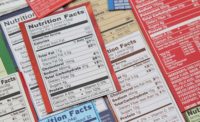Just the facts; only the facts

By now, you’ve heard about the proposed updates of the Nutrition Facts labels on food packages. After nearly 20 years, the Food and Drug Administration (FDA) has finally gotten around to making a few changes, such as listing calorie counts in larger type and adjusting portion sizes to reflect a more realistic portion. By no means is this coming soon enough. The changes are the first significant revisions of nutrition information on food labels since the government began requiring it in the early 1990s. Tsk, tsk.
According to Chicago-based global research firm the NPD Group, interest in reading labels has steadily waned among U.S. households. NPD Group says its ongoing food and beverage market research indicates that consumers read the labels when they first appeared, but as time went on, many stopped checking them for what’s in their food.
“The most likely reason for this decline is that the effort succeeded in educating Americans about what’s in their food,” explains Harry Balzer, chief industry analyst at NPD and author of Eating Patterns in America. “After all, how many times do you need to look at the Nutrition Facts label on your favorite cereal, or your favorite juice, and any other food you routinely consume?”
The firm also tracks what consumers actually look for on the Nutrition Facts label when they do read it. According to NPD’s Dieting Monitor, which examines top-of-mind dieting and nutrition-related issues facing consumers, the top five items consumers search for are—in consecutive order—calories, total fat, sugar, sodium and calories from fat.
“It’s a safe bet that Americans now want more information, but be careful, there are always new issues that come up every few years,” says Balzer. “If the Nutrition Facts label is to continue to educate, it should allow for changes more often than once every 20 years. For example, gluten, probiotics and Omega 3s weren’t on the radar screen 20 years ago.” Exaaaactly!
The changes include a separate line for sugars that are manufactured and added to food, substances that many public health experts claim have contributed substantially to the obesity problem in this country, according to an article in The New York Times. That puts sugars right in the cross hairs, states Dr. David A. Kessler, former commissioner during the original push for the labels in the 1990s.
With that, this month’s issue is filled with several relevant topics about nutrition, health and bakery and snack food industry trends. In our Health & Wellness column, Christine Cochran, executive director of the Grain Foods Foundation (GFF), Washington, discusses sodium and how much (or little, as the case may be) of it we should be consuming. She raises the key question: How much is too much?
And we still don’t get enough whole grains in our diets, as our Ingredient Technology article this month can attest. At least half of the grains in a person’s diet should comprise whole grains, which are unrefined, with the bran and germ intact. For most adults, that means three to five servings of whole grains daily (or two to three for kids). Our report shows that we Americans just aren’t getting enough. Most Americans eat less than one serving of whole grains each day.
Elsewhere in the issue, food-safety columnist Gale Prince reminds us that one of the most important parts of the food business today is keeping up with the new food-safety regulations. For many bakeries and snack food companies, this task is a full-time job for one or more individuals within their operations.
Another concern is that many of us don’t start our day with a healthy breakfast. But that can be rectified easily with the barrage of handy and quick, take-along breakfast items that we feature in our Market Trends section. Marketers are boosting breakfast foods with more nutritional value, good taste and convenience for busy on-the-go lifestyles.
And be sure to check out our special Tortilla Trends section, which further explores consumer interest in better-for-you foods and portability, as well as new uses for tortillas.
So, take a further look at those Nutrition Facts labels on the products you buy and those you make, and see what you find. You may be surprised at what they will soon reveal.
Looking for a reprint of this article?
From high-res PDFs to custom plaques, order your copy today!





